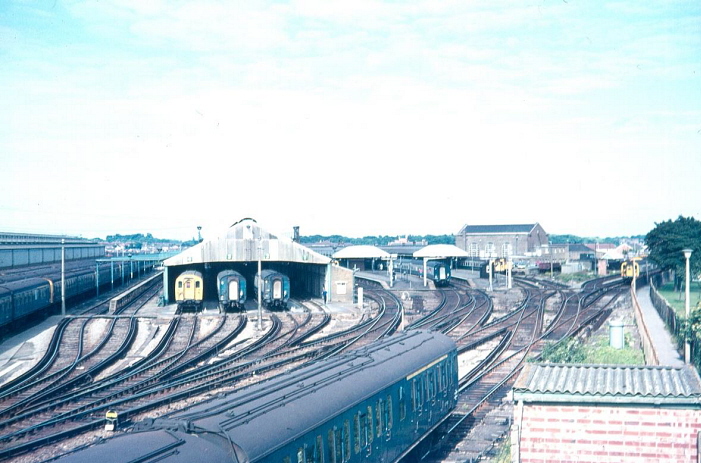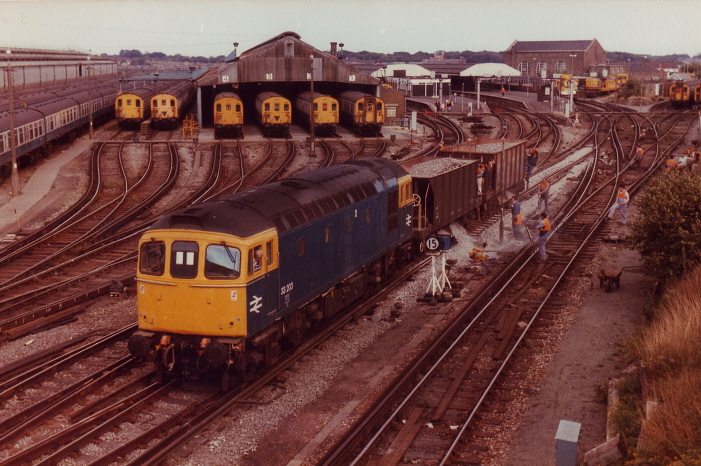
Ramsgate
The Thanet re-organisation involved closing engine sheds at Deal and Margate,
and concentrating locomotive facilities at a new, larger motive power depot at
Ramsgate. Carriage berthing in the area was also incorporated into layouts at
both Margate and Ramsgate. The former’s heavily revised arrangement incorporated
five lengthy westward-facing sidings to the south of the main station complex;
Ramsgate housed rolling stock sidings and, latterly, carriage cleaning apparatus. Just
under 45-foot beyond Ramsgate’s northern-most island platform existed seven loop
carriage sidings, extending about 900-feet. Circa 1934, four
of these tracks were covered for 655-foot of their length by a pitched-roof
steel-framed structure clad with corrugated asbestos, this becoming the carriage
cleaning shed. Immediately north of the carriage stabling sidings existed the motive power depot approach roads.
The engine shed was positioned to the north-west of the former and comprised
six eastward-facing tracks housed within a 245-foot long dead-end building. This
was built wholly from concrete, featured a ridge-and-furrow roof, and was fed by
a 64-foot 9-inch turntable located to its east (the engine shed is looked at in
greater detail within the
Ramsgate MPD section). To the immediate north of
the shed were engine stabling roads, which included a mechanical coaling tower,
a water column, and an imposing water softener, this of which fed the depot’s
large water tower.
The remainder of the site’s northern territory was
occupied by a spacious goods yard. Included within this arrangement was a
160-foot long, 40-foot wide, brick-built goods shed: this was a through-affair,
accommodating a single-track, and attached to its western elevation was a
65-foot-long appendix of pitched-roof offices. The goods shed (complete with
nearby cattle pens) resided 70-foot north of the engine shed; beyond the former
existed eight lengthy, well spaced-out sidings. Isolated from the yard,
but nevertheless involved in the goods handling capacity, was a westward-facing
dock line. This was positioned immediately adjacent to the main station building
and was served by a 175-foot-long platform face.
Finally, the entire layout was
controlled by a 50-foot-long two-storey-high signal box, this of
which backed onto the southern elevation of the carriage cleaning shed. The
cabin was an attractive brick-built pitched-roof gabled affair, to a design
reminiscent of those earlier products of signalling contractor Saxby & Farmer.
The rebuilt Ramsgate station had the interesting characteristic that passengers could
catch a train bound for London in either direction.
The fact that Ramsgate was a recent layout ensured that throughout the rest of
the steam era, virtually nothing changed at the site. Indeed, the £25 million
(£430 million at 2006 prices) ‘’Phase 1’’ of the Kent Coast Electrification
Scheme brought significant changes to the rolling stock infrastructure at the
site, but the station itself witnessed little in the way of alterations, the platforms still
retaining their swan-neck lamp posts, ‘’Target’’ name signs, and copious
canopies. In June 1958, the first sections of conductor rail arrived at the
site and track revisions soon began. A trio of new 170-yard-long
westward-facing sidings were laid on the still extant track bed which formerly
accommodated the approaches to the ex-SER Ramsgate Town station. Track foot
crossings for staff were laid at the western ends of the platforms and across
the aforementioned additional sidings, producing a walkway fifty yards in
length. The carriage cleaning shed received third rail in preparation for its
conversion to an electric multiple unit inspection shed, and the exterior was
re-clad once again in asbestos. The loop sidings which flanked the outer
platform lines – one on each side – were equipped with electric lighting
supported upon metal lamp posts, and the three new berthing tracks were
similarly treated. The island platforms were extended with prefabricated
concrete to a length of 890-foot and new signal posts emerged at either end of
these surfaces, supporting four-aspect colour lights. The new signalling
came into use on 19th July 1959, but the existing signal box was retained to
control the mass of sidings still present at the site. However, the cabin
received a relay room to continue this function, on the advent of track
circuiting.
Trial
electric running between London and Ramsgate began on 1st June 1959 and
although the full accelerated timetable for the ‘’Chatham’’ main line came into
use on 15th of that month, alterations at Ramsgate were far from complete. By
the end of the year, work had started to convert the steam locomotive shed into an
EMU maintenance depot. This resulted in the demolition of a third of the
existing concrete structure, leaving the two southern-most shed roads exposed,
and the building of a 580-foot-long extension onto the eastern elevation of the
building’s remains. The extension covered four tracks and was constituted of a
pitched-roof steel frame clad with asbestos. The three-storey-high water tank on
the shed’s northern elevation was retained, and a brown brick wall was erected
to fill in the southern side of the shed, which had become exposed due to the
aforementioned demolition. In December 1960, these particular works were deemed
complete.
The goods yard sidings were re-arranged for rolling stock berthing
and at the northern extremity of the site, a heavy maintenance depot was
erected. This was a three-road affair, constituted of two steel-framed
asbestos-clad buildings end-on to each other, and resided at about twenty
degrees to the other sidings. The western of the two structures was
single-storey with a pitched roof, measuring 255-feet in length; the second
building was two-storeys high, 100-foot in length, and accommodated three
upward-sliding doors. The goods shed building was retained, but lost its rail
connection. EMU washing apparatus was installed to the west of the station
layout, beyond the road bridge, on the northern-most line of the station’s
four-track approach. Finally, the earlier mentioned dock line was retained for
permanent way formations, but was not electrified.
In 1975, a single-storey CLASP Train Crew Accommodation Block was erected at the Canterbury
end of the northern island platform, end-on to the platform canopy. Previously,
the ornate gas lamps had given way to more austere electric types, and the
green-backed name boards had been removed in favour of plain replacements
bearing black text on a white background. Little else at the site has changed
since. In the year 2000, a re-roofing exercise sought to replace the dreary
asbestos cladding which covered the EMU inspection shed and the adjacent
maintenance depot. In the place of this material emerged corrugated metal
sheeting, patterned in blue and grey. In 2005, it was announced that the EMU
maintenance shed at the site was to enter a programme of upgrading, in
preparation for the impending Class 395 ‘’Javelin’’ high-speed units. Such works
were scheduled to be completed during September 2007.
18th July 1971

A general panorama of the station layout is observed on 18th July 1971, with the heavy maintenance depot on the left, the EMU storage shed (ex-carriage cleaning shed) in the centre, and on the right, the station platforms. The sidings on the far right were added as part of the Kent Coast Electrification Scheme and are positioned upon the former track bed to Ramsgate Town station. © David Glasspool Collection
1984

Turning the clock forward by just over twelve years, the layout is seen from the same viewpoint, and the track layout remains unchanged. An impressive line-up of suburban and Kent Coast units form the backdrop of this view, which includes No. 33203 on ballasting duties. In evidence is the CLASP Train Crew block, at the end of the northern island platform. Train crew accommodation has since moved to the former Red Star Parcels Office. © Chris
1996

InterCity-liveried Class 47 No. 47840 is depicted alongside platform 1 in 1996, just after bringing in the Cross Country service from Birmingham (1O99). Of course, by this time the service was operated by Virgin Trains, but the train livery was to the contrary. © Andre Kent
Return to the Kent Rail Homepage or alternatively, check for Updates.
Website & Copyright information - Links - Contact the Webmaster
All content is copyright © David Glasspool unless otherwise stated